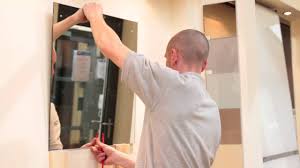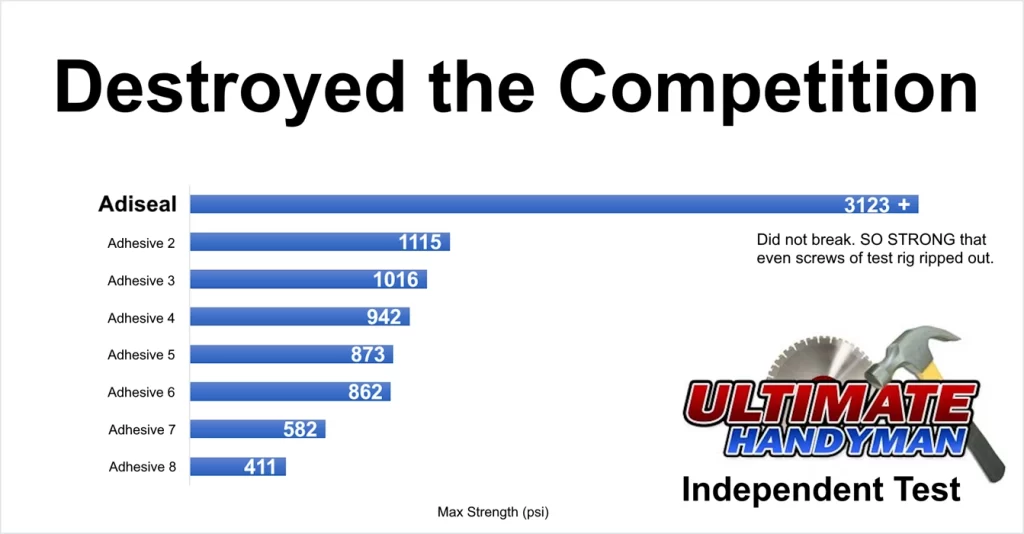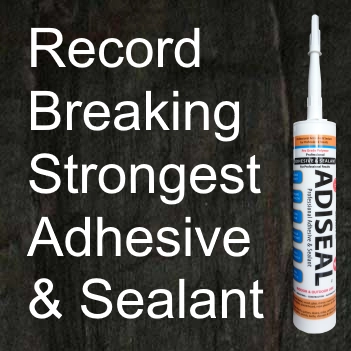Mirror Adhesive
MIRROR ADHESIVE: Strong Mirror Fix Glue Bond
To stick or glue mirror with a mirror adhesive, Adiseal has been shown to be the strongest adhesive in an independent adhesive strength test. It is a high-performance product that provides a strong, flexible, waterproof and durable bond on mirrors.
Adiseal will safely stick mirrors to various materials including tiles, wood, metal, stone, brick, concrete, plastic, plaster and many other materials. Some of the mirror bonding applications Adiseal can be used for include glue mirror to wall, wardrobe door, glue car mirrors and many other mirror bonding applications.
- Why mirrors need a special adhesive
- What is the best adhesive to hang mirrors
- What are the benefits of Adiseal mirror adhesive
- How to stick mirror with an adhesive

Why mirrors need a special adhesive
Although most adhesives can bond mirrors, most products are not suitable to use on the mirror backing. This is because the reflective backing on a mirror is a sensitive material that can be damaged easily. Most adhesives will attack this mirror backing and damage it. Adiseal is safe to use on mirror backings and will stick mirrors to various materials and surfaces, providing a strong durable bond.
What is the best adhesive to hang mirrors?
Adiseal is the strongest mirror safe adhesive available. In an independent adhesive strength test carried out by Ultimate Handyman, Adiseal outperformed all other adhesives, proving its superior strength.

Best adhesive test results table
| Product | Max pressure when adhesive bond broke (psi) |
| Adiseal | 3123 + psi |
| SupaBond | 1115 psi |
| Tec 7 | 1016 psi |
| HB42 | 942 psi |
| Loctite PL Premium | 873 psi |
| Gorilla Grab Adhesive | 862 psi |
| Bond It PU18 | 582 psi |
| Bond It Save Nails | 411 psi |
“That is actually unbelievable!”
Ultimate Handyman
Testimonials
Testimonials & some comments on the: Grab adhesive tests 2017, video on YouTube
- That Adiseal is phenomenal!
- That Adiseal is some stuff though, definitely need to get some of that bought!
- I instantly went looking for Adiseal!
- Need to get my hands on some of that to try out.
- Looks like a cracking product.
- Having used the two most expensive brands on numerous occasions, I’ll be trying out the others, especially the Adiseal.
- Adiseal certainly surprised me in this test!
- Fantastic tests. It’s unbelievable that Adiseal test with the hardwood.
What are the benefits of Adiseal mirror adhesive?
How to stick mirror with an adhesive
How to stick mirror with an adhesive
- Prepare the Surface
Ensure that the surface where you will be attaching the mirror is clean, dry, and free of any dust, grease, or debris. Use a suitable and mirror safe cleaner to remove any residues.
- Apply the Adhesive
Apply the adhesive to the back of the mirror ensuring even coverage. Be cautious not to apply too much adhesive, as excess adhesive can squeeze out and be visible around the edges of the mirror. Covering as much surface area as possible will provide a stronger bond.
- Position the Mirror
Carefully place the mirror onto the prepared surface, aligning it with the desired position. Press firmly, applying even pressure across the entire surface of the mirror to ensure good contact between the adhesive and the surface.
- Support the Mirror
If necessary, use temporary supports, such as adhesive tape, clamps or brackets, to hold the mirror in place while the adhesive cures.
- Remove Excess Adhesive
Wipe away any excess adhesive that may have squeezed out around the edges of the mirror. Be careful not to disturb the position of the mirror while doing this.
- Allow Proper Curing Time
Avoid disturbing or putting stress on the mirror during the recommended curing time. This allows the adhesive to fully set and ensures a strong bond.
Tip: To store Adiseal mirror adhesive once opened, leave about 1cm worth of product out of the nozzle and store the tube upright in a cool dry place. To re-use Adiseal, pull the cured part out or cut the nozzle until the uncured part is reached.

Stick mirror to wall
Glue mirror to wall using the following steps for a strong bond:
- Clean surfaces: Thoroughly clean both the mirror and wall surfaces to remove dirt and contaminants that can affect the bond.
- Apply adhesive: Use Adiseal adhesive mastic and apply it to one surface, covering a sufficient area for a strong bond.
- Secure mirror: Position the mirror against the wall, pressing firmly for proper adhesion. Consider using temporary supports if needed.
- Allow curing time: Adiseal typically takes 24-48 hours to fully cure. Follow the manufacturer’s instructions for the specific curing time.
- Remove excess adhesive: Wipe away any uncured adhesive with a cloth. Use Adisolve if necessary, but avoid using it on the mirror backing.
- Consider moisture: If bonding non-porous materials, lightly spray water on one surface before applying the adhesive to aid in the curing process.
Stick mirror to wardrobe door
To stick a mirror to a wardrobe door, follow these steps for a strong and lasting bond:
- Clean surfaces: Ensure both mirror and wardrobe door surfaces are clean. Use Adisolve to remove dirt and debris, and wipe surfaces thoroughly.
- Apply Adiseal adhesive: Apply Adiseal adhesive to one surface, covering enough area for a strong bond.
- Position the mirror: Press the mirror onto the wardrobe door surface, aligning it carefully. Use temporary supports if needed for vertical placement.
- Allow curing time: Adiseal typically cures in 24-48 hours. Follow manufacturer’s instructions for optimal bond strength. Avoid disturbing the mirror during curing.
- Remove excess uncured adhesive: Wipe away any excess uncured Adiseal using a cloth. Use Adisolve if necessary, but avoid contact with the mirror.
Stick mirror to tiles
To adhere a mirror to tiles using Adiseal mirror adhesive, follow these steps:
- Clean surfaces: Ensure both mirror and tile surfaces are clean from dirt and debris before applying the adhesive mirror mastic.
- Apply adhesive in vertical strips: Use Adiseal mirror adhesive and apply it in thin vertical strips on one surface. This allows for even distribution and water to run down instead of building up.
- Press mirror onto tiles: Align the mirror and firmly press it onto the tiled surface with the adhesive strips.
- Allow curing time: Adiseal takes 24-48 hours to fully cure. Use temporary supports to prevent the mirror from sliding while the adhesive cures.
- Remove excess uncured adhesive: Wipe away any excess uncured Adiseal with a cloth for a clean finish. Use Adisolve to remove remnants if needed.
- Consider moisture for non-porous surfaces: Spray a small amount of water on one surface if the tiles and mirror are non-porous. This provides moisture for proper curing.
Glue mirror to wood
To glue or attach mirror to wood without drilling, follow these steps for a secure bond:
- Clean surfaces: Ensure both mirror and wood surfaces are clean before applying the adhesive.
- Match surfaces: If the wood surface is not flat, adjust it to closely match the mirror surface using cutting, filing, or sanding.
- Apply Adiseal adhesive: Apply Adiseal adhesive to one surface and carefully press the mirror onto the wood.
- Use temporary supports: For vertical surfaces, use temporary supports to prevent the mirror from sliding until the adhesive fully cures.
- Allow curing time: Adiseal can take up to 48 hours to fully cure. Consider using temporary supports during this time to prevent the mirror from sliding.
- Remove excess uncured adhesive: Wipe away any excess uncured Adiseal with a cloth. Use Adisolve to effectively eliminate any remaining residue.
Bond mirror to metal
To glue a mirror to metal, follow these steps for a strong bond:
- Clean surfaces: Thoroughly clean both mirror and metal surfaces to ensure a strong bond. Remove any surface oils from the metal.
- Apply Adiseal adhesive: Apply Adiseal to one surface and carefully press the mirror onto the metal, aligning it properly.
- Use temporary supports (if needed): For vertical metal surfaces, consider using temporary supports until the adhesive fully cures.
- Remove excess adhesive: Wipe away any excess adhesive using a cloth. Use Adisolve to remove uncured adhesive or oil residue from the metal.
- Consider moisture for non-porous surfaces: Spray a small amount of water on one surface before applying the adhesive if both mirror and metal are non-porous. This helps with the curing process since Adiseal requires moisture.
- Allow extra curing time: Give the adhesive additional time to fully cure, considering the non-porous nature of the materials.
Adiseal is also suitable for automotive applications, making it a reliable choice for gluing mirrors inside vehicles.
Car wing mirror adhesive
Adiseal is ideal for securely attaching a car or vehicle wing mirror in automotive mirror adhesive bonding applications. Adiseal is suitable at sticking car wing mirrors, side mirrors, rear view mirrors and any other car or vehicle mirror.
To stick a car mirror, thoroughly clean the surfaces before applying the adhesive for a strong bond. Push the mirror thoroughly but carefully to the surface. Temporary supports may be needed to prevent sliding during curing, ensuring a strong and durable attachment. Remove any excess adhesive that may squeeze out of the side of the mirror.
We have successfully stuck back a car wing mirror that came off the wing mirror housing due to the manufacturer adhesive failing over time. As it was a heated wing mirror, the hot and cold temperature changes had caused the car manufacturers adhesive to fail. Adiseal was then used to stick the car side mirror back into the housing, providing stronger adhesion then before.
Sticking mirrors to stone
Adiseal is highly effective for securely adhering mirrors to stone or concrete surfaces. Thoroughly clean both surfaces before applying the adhesive. With Adiseal, additional sealing is unnecessary for porous stone or concrete. For vertical applications, use temporary supports to prevent any sliding during curing, ensuring a secure and stable bond.
Mirror tiles adhesive
Adiseal is an excellent adhesive choice for securing mirror tiles. When using Adiseal for this purpose, ensure the surface is clean, dry, and free from dust or grease. Apply the adhesive to the back of the mirror tile evenly, then firmly press the tile onto the desired surface, ensuring proper alignment. Adiseal’s quick grab and high bond strength provide immediate and secure attachment, while its moisture resistance ensures long-lasting bonding of the mirror tiles.
Glue for mirror
Adiglue is a high-strength glue for mirror. For most mirror bonding applications, we recommend using Adiseal, as it offers a stronger and more durable bond than Adiglue. While Adiglue has the advantage of quicker curing, it may not provide the same level of long-term strength and flexibility as Adiseal, which ensures the mirror remains securely attached, even when exposed to movement or environmental changes.
Mirror sealant
Adiseal is also a mirror sealant due to its neutral cure properties. Adiseal mirror sealant will provide a strong fix on mirrors without attacking the sensitive mirror backing.
Colours
Adiseal adhesive and sealant is available in the following colours:
- White adhesive and white sealant
- Black adhesive and black sealant
- Grey adhesive and grey sealant
- Clear adhesive and clear sealant
- Brown adhesive and brown sealant
Adiseal can also be manufactured in any RAL colour.
Please note Adiseal adhesive sealant colours provides a stronger bond on mirrors and other materials compared to the clear version.
Where to buy mirror adhesive
In the UK, Adiseal mirror adhesive or mirror glue can be purchased from Adiseal stockists. Please contact us for details of your local stockist. For other countries visit www.guglue.com
Frequently asked questions about mirror adhesive
Adiseal has been shown to be the strongest adhesive in an independent adhesive strength test. It is also safe to use on mirrors without attacking the sensitive mirror backing material.
While many adhesives have the ability to stick a mirror, not all are suitable for this purpose. It is important to consider the sensitivity of the mirror backing, as certain adhesives can cause damage and deterioration.
Adiseal can stick a mirror in a car. It can stick mirrors to many different surfaces in a car. These include plastic, metal, leather, wood and other materials in a car, van or any other vehicle.
Mirror adhesive is suitable for a variety of surfaces, including drywall, plaster, wood, concrete, ceramic tile, and glass.
Some products are designed to be resistant to moisture and humidity, making them suitable for bathroom or kitchen mirror installations. Always check the product label for specific information.
Some products like Adiseal are suitable for use both indoors and outdoors.
Adiseal is our best adhesive for mirrors. If provides a high-strength, flexible and waterproof bond when mounting mirrors.
Mirrors backing is a sensitive material that can easily be damaged if the wrong products is used. Adiseal provides a strong, flexible, waterproof & durable bond on mirrors whilst remaining safe for the mirror backing.
